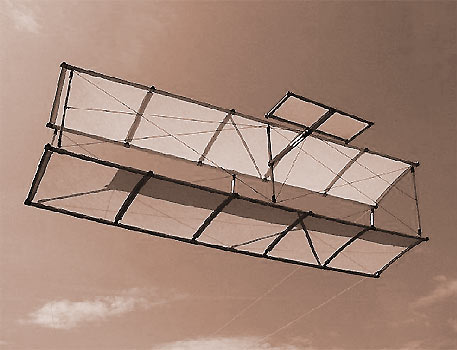History of a kite
which becomes a plane
by the Wright Brothers |
1899
- Getting acquainted with aeronautics
In the 1890's aviation was a wide-open field
of study that provided rich possibilities for investigation.
After collecting reference material from the Smithsonian and other
sources, the Wright brothers began studying their predecessors.
They were surprised to learn that, despite humanity's centuries-old
interest in flight, little progress had been made in aeronautics
before 1800. Until that time, few trained scientists or mechanics
thought it a sensible undertaking.
|
| |
During the 1800s, however, a community of technically trained
people interested in flight had evolved. They had amassed a body
of aeronautical knowledge that represented the first real steps
toward achieving human flight.
|
|
| |
|
|
diorama
by
Wokipi
Video of tests and reflections about the
Kite flight
below
|
| |
|
In the early summer of 1899, Wilbur Wright stood in his bicycle shop in Dayton, Ohio, and was chatting with a customer who had come for an inner tube, idly twisting a small cardboard box. With his thumbs and index fingers, he squeezed two diagonal corners on one end of the inner |
| tube box and the two opposite corners on the other end. When he did this, the box twisted. |
|
| |
In his mind's eye, Wilbur saw the top and bottom of the box as the wings of a biplane. By using cords or wires to pull the corners together, one end of each wing would turn up while the other turned down. This system could be used to control the biplane, making it roll right or left.
Both ends of the wings would move at the same time, changing their angle of attack in opposite directions. The end the turned up (and had a higher angle of attack) would generate more lift, while the end that turned down (with a lower angle of attack) would have less lift. The end of the wing with more lift would rise while the other fell.
So, Wilbur Wright discovered a method for controlling an aircraft in flight that history now remembers as "wing-warping" |
| |
 |
Wilbur talked the idea over with his brother Orville, and the two designed an experiment to test it with a "kite."
Wilbur and Orville had already grasped the theory behind this method some months before. After reading a book on the mechanics of bird flight, they observed buzzards circling above the Great Miami River. IThey determined that a bird rolls left or right by changing the angle at which the wings meet the wind, tilting one up and the other down simultaneously.
So they built a biplane "box" kite with wings 5 to 6 feet long and 13 to 15 inches wide. The wings where held 13 to 15 inches apart by several struts, and all the parts were hinged so they could move. A small tail was attached to the back middle strut.
The Wrights controlled the kite from the ground with four strings. One end of each string was tied to one end of the front outboard struts. The other ends were tied to the ends of two sticks.
By angling the sticks in opposite directions while the kite was flying, the Wright brothers could "warp" the wings and cause the kite to bank right and left.
By angling the sticks in the same direction, they could raise or lower the tail, making the kite climb or dive. |
| |
|
Over the next few months, the Wrights built and flew several "scientific" kites, perfecting their control system. In 1900, they used this system on a man-carrying glider for the first time.
Before they risked their own necks, they flew the glider as a kite, controlling it from the ground. These scientific kites were hung about the bicycle shop until 1905, when the Wright brothers had finally developed a practical powered airplane. They decided to clean house, and took the kites outside to burn. Most were destroyed, but they gave several to some neighbor kids who happened by. |
| |
|
|
|
|
|
Video of tests and reflections about the
Kite flight |
First Fly video (1903) :
Crédit Vidéo : Arte |
| |
|
| photo credit of this page : Wokipi and www.wright-brothers.org |
| |
|
|